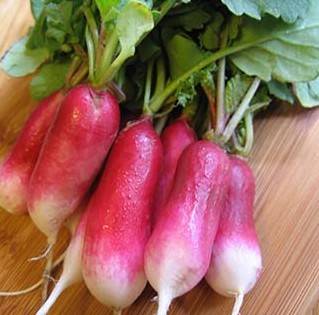 Sure we’ve had record rain and it’s been unseasonably cool. You would think this would guarantee the mildest radishes ever. Unfortunately, you’d be wrong. Whether radishes are hot depends less on whether they’ve had to endure hot temperatures and more on how long it took them to reach maturity.
Sure we’ve had record rain and it’s been unseasonably cool. You would think this would guarantee the mildest radishes ever. Unfortunately, you’d be wrong. Whether radishes are hot depends less on whether they’ve had to endure hot temperatures and more on how long it took them to reach maturity.
Most radishes mature in 30 days or less. Early spring radishes like Easter Egg, which can be any color from white to dark purple, take 25 days to mature. Cherry Belles, which are red and round as their name suggests, take just 22 days. Varieties that can be grown in early or late spring like Icicle, which are finger-length and white, and French Breakfast, which are finger-length and red topped, mature in 25 and 23 days, respectively. .
Cool, wet cloudy days like we’ve had this spring don’t promote rapid growth for radishes. Because of this, many local radishes had a prolonged growing season and are packing heat this year.
But don’t let that deter you from picking up a bunch at the farmers market and Common Ground Food Coop. Even the spiciest of radishes can be tamed with the right recipes.
Radishes that are only mildly spicy are still good for radish sandwiches. Make these with thinly sliced radishes on buttered thinly sliced white bread. Trim the crusts and cut into small squares for classic tea sandwiches. Or, make radish crostini. Brush thinly sliced slices of baguette with olive oil. Toast in the oven on a baking sheet or directly on the rack of a toaster oven. Top with thinly sliced radishes and sprinkle with salt and pepper.
For radish sandwiches with hotter radishes, slice or mince radishes and place them on a bagel or black bread with some cream cheese as University of Illinois extension suggests.
Of course, even the spiciest of radishes can work in green salads. Just use fewer radishes if they are hotter. For potlucks, use radishes to give a little heat to black bean and corn salad. Combine drained, cooked/canned black beans; thawed, frozen sweet corn; chopped cilantro; and radishes slices. Squeeze on some lime juice, a drizzle of olive oil, and sprinkle with a little cumin and/or chipotle powder.
Spicier radishes also can be tamed with cooking. They will lose a bit of their bright color, but loss of color will be offset by gains in sweetness as the heat from cooking concentrates the radishes’ natural sugars. Because of this, cooked radishes often make radish converts of people who wouldn’t dream of eating them on from a veggie tray at party.
You can roast radishes on the grill or in the oven. To roast via grilling, thread them on skewers. Brush them with olive oil and sprinkle with Kosher salt. Place them over indirect heat until they are fork-tender. For oven roasting, quarter large radishes and cut smaller ones in half. Coat lightly with olive oil and sprinkle with Kosher salt. Then place them in a cast iron skillet or on a baking sheet in a 375 degree F oven for 20 to 25 minutes until they are fork-tender.
Radishes also can be steamed in a rice cooker or vegetable steamer like cauliflower.
Finally, you can sauté radishes. Slice them in half or quarter if larger. Saute in a heavy pan over moderate heat in butter or olive oil or a combination until fork-tender, stirring occasionally. Sauteed radishes go well with sauteed or steamed kale and pasta or chicken, pork, veal, or tofu piccata.








